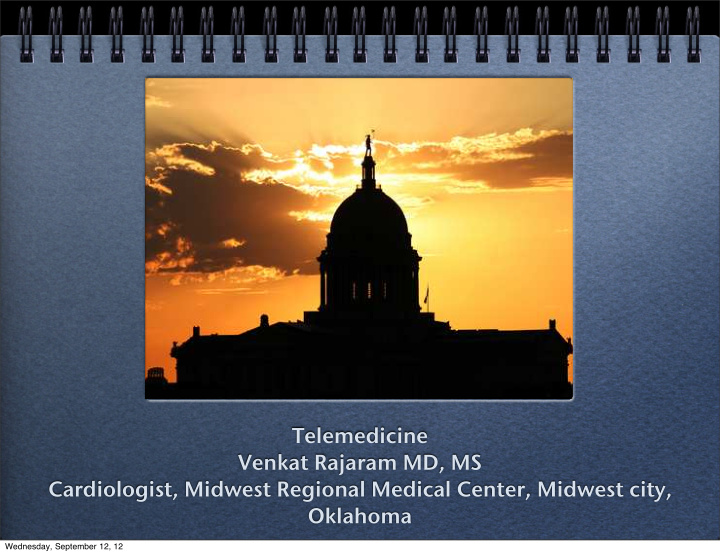



Telemedicine Venkat Rajaram MD, MS Cardiologist, Midwest Regional Medical Center, Midwest city, Oklahoma Wednesday, September 12, 12
Purpose Highlight the need focusing on cardiovascular diseases Explain practical issues based on my experience Implications for policy Wednesday, September 12, 12
Major Cardiovascular Diseases Death rate (age-adjusted) Heart Disease and Stroke Statistics—2012 Update Wednesday, September 12, 12
Age Adjusted Death Rate for 100,000 population Cardiovascular Diseases Coronary Diseases Stroke Death % Death % Death % Rank Rank Rank Rate change Rate change Rate change OK 49 322.4 -20.6 50 176.2 -23.5 49 54.4 -20.5 US 262.7 -22.6 135.1 27.7 44.1 -26.9 % change between 1991-2001 and 2005-2007 Heart Disease and Stroke Statistics—2012 Update Wednesday, September 12, 12
Access to Care The 2008 data shows 2.4 physicians per 1000 population, ranking the state 44th. OK state board of health Wednesday, September 12, 12
Telemedicine Telemedicine is the use of telecommunication and information technologies in order to provide clinical health care at a distance. It helps eliminate distance barriers and can improve access to medical services that would often not be consistently available in distant rural communities. Wednesday, September 12, 12
What is not telemedicine? Telephone contact of patients Email contact with patients Text messaging Online prescriptions for established patients. Any form of communication that is not protected and saved in accordance with the law. Wednesday, September 12, 12
Categories of Telemedicine 1. Store and forward 2. Remote monitoring 3. Interactive (real time) services (elective vs. emergency services) Wednesday, September 12, 12
Equipment Appropriate room with lighting, privacy, security and assistance Equipment with adequate audiovisual capabilities Adequate transmission capabilities including speed and resolution Secure storage and retrieval in complaince with HIPAA regulations Adequately trained personnel Wednesday, September 12, 12
� � � � � � � � � � � � � � � � � � � � � � � � � � � � � � � � � � Wednesday, September 12, 12 � � � � � � � � � � � � � � � � � �� � � � � � � � � � � � � � � � � � � � � � � � � �� � � � � � � � � � � � � � � �
Who is a “PRESENTER”? The presenter is an individual, located at the patient remote site that provides support to the patient and the telemedicine consulting provider, in completing the physical examination and/or telemedicine activity. Usually a LPN with training in handling the videoconferencing equipment and the basics of clinical exam Wednesday, September 12, 12
Role of Presenter Scheduling-Appropriate provider and follow up Preparation- of patient, equipment including trouble shooting Obtain consents, follow patient privacy Help with equipment such as positioning and with exam during encounter Maintenance of equipment including servicing Arrange for appropriate follow up testing/ apointments Wednesday, September 12, 12
Follow up care Mobile labs/blood collection Mobile EKG and echocardiography (including portable units) needs to co-ordinate care following the encounter with the specialist. Wednesday, September 12, 12
Telecardiology Remote monitoring of patients with congestive heart failure reduces mortality and hospitalizations, often through improved patient compliance to medical care. Cochrane Database Syst Rev 2010; 8: CD007228. Enhanced speed of care of patients with acute myocardial infarction (heart attack) with EKG transmission from critical access hospitals to specialized center can improve care. Wednesday, September 12, 12
Telestroke This could be a useful tool in identifying patients who would require clot busters (thrombolysis) for acute stroke. Only 3% to 5% of ischemic stroke patients are treated with thrombolysis The top 3 clinical needs met by the telestroke were emergency department consultation (100%), patient triage (83.8%), and inpatient Stroke. 2012;43:2078-2085 Wednesday, September 12, 12
Patient Satisfaction Despite small sample sizes and methodological inadequacies studies suggest comparable patient satisfaction to traditional encounters Factors considered favorable include early appointment scheduling, travel time, and patient involvement in the physical examination and access to care. 1. BMJ. 2000 June 3; 320(7248): 1517–1520 2. Susan S. Gustke, David C. Balch, Vivian L. West, and Lance O. Rogers Telemedicine Journal. May 2000, Vol. 6, No. 1: 5-13 Wednesday, September 12, 12
Implications for Policy Licensure requirements for physicians as well as providers Requirements for the telemedicine facility and equipment Policies to promote infrastructure such as high speed internet, wireless facilities, equipped centers etc. Requirements for protected storage and retrieval for later review should the need arise. Protection of patient rights and privacy Clear definition of what constitutes telemedicine for purposes of records and billing. Physician and sta ff compensation. Wednesday, September 12, 12
Thank you Wednesday, September 12, 12
Recommend
More recommend